The Best Album Covers Of 2022, Ranked
Including a euphoric desert blues album, a raucous eco-punk affair, a spiritual jazz odyssey and more.
Including a euphoric desert blues album, a raucous eco-punk affair, a spiritual jazz odyssey and more.
From a listener’s standpoint, there are two sides to the music streaming era coin: on-demand access and oversaturation. To access a wide range of music with a few taps at a device is an undeniable wonder, but this unbridled ease of access and the vastness of choices at our fingertips can get overwhelming, especially when you consider how much new music comes at us thick and fast. In this post-digital wonderland where every piece of music seeks attention, the value of cover arts and images as introductory first impressions is as invaluable as it’s ever been.
No matter how highly anticipated a body of work is, a project’s cover has the power to dampen expectations or further hype. For more obscure releases, a great cover can be the difference between a listener giving the music a chance or entirely skipping it. More than attracting pieces, great cover arts simultaneously preempt the sonic adventure in the music and serve as companion pieces that heighten the experience of listening to the music. In our inaugural list of the Best Cover Arts in music from the past year, The NATIVE’s editorial team combed through projects from across the African music landscape, considering aesthetic quality and value to the music.
Including a euphoric desert blues album, a raucous eco-punk affair, a spiritual jazz odyssey and more, here are the ten best project covers of 2022.
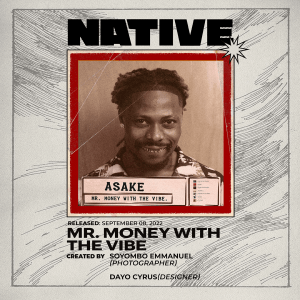
Sometimes, all you need is just the perfect reference image. After months establishing himself as the newest Afropop superstar on the block, on the back of a glorious EP packed with smash hits and a few blistering guest appearances, Asake’s first album needed to be an all-time debut project. Before its release, the set-up was perfect: A cover image that aptly imitated the eternal mugshot of Colombian drug lord, Pablo Escobar. The singer’s rap sheet is different, anointing himself the most sought after man in Nigerian pop for hijacking the charts. It was a statement that ‘Mr Money With the Vibe’ would consolidate on that feat, and it did, helped along by a cover that became iconic the moment it was unveiled.
Dennis Ade Peter
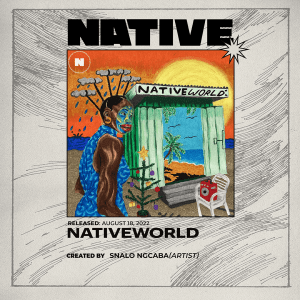
For its debut compilation album, ‘NATIVEWORLD’, NATIVE Sound System enlisted South African artist Sinalo Ngcaba to represent the sonic textures referenced from Nigeria’s weather seasons. With the background information of the seasons and colourful songs from the album cut from the cloth of Afropop, Sinalo reflected the rich sounds using oil pastels and Procreate. Her choice of bright colours stem from her aim to create an image that, like the project, was an instant mood pick up. She shared that the bright colours “evoke such emotion and usually, the brighter the colour, the brighter the mood you get from it.” With its door bearing title, Sinalo’s cover is a warm invitation to NATIVE Sound System’s expansive, tasteful selection and marriage of some of the best sounds emanating from these parts.
Nwanneamaka Igwe
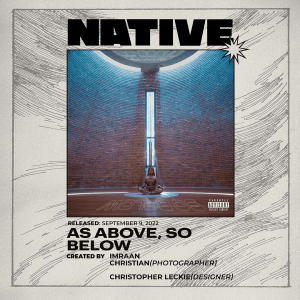
When looking at album covers or art pieces in general, my eyes are immediately attracted to proper composition, otherworldly lighting and smooth textures. I don’t think any Album cover from this year better embodied the captivating nature of these features as Sampa The Great’s ‘As Above, So Below’. From the earth-tone grading and Sampa’s Lotus Position to the Ethereal atmosphere and the CGI-like composure, the entire cover is the perfect accompanying piece to the music, a self-reconnecting journey that, according to Pitchfork’s Stephen Kearse, “folds together zamrock, polyrhythmic percussion, and choral harmonies.” It’s clear that a lot of thought was put into creating this cover and that same attention to detail is littered all over the album.
Israel Ajayi
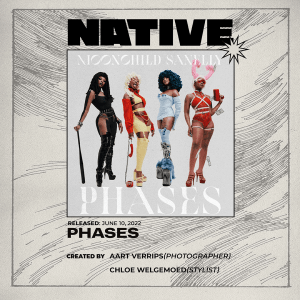
Midway through the year, South African dance-fusion singer and rapper Moonchild Sanelly shared her splendid sophomore album, ‘Phases’. On her best project yet, Sanelly is vulnerable and ultra-confident, vivacious and reflective, asserting her person across multiple scenarios in certain terms and continuing to show herself as an irreverent advocate for African women to be who and what they want to be. All of that is represented on its cover, an assembly of four different versions of Sanelly. With each version donning different hairstyles and adorned with varying outfits, the four looks range from goth to exotic dancer, representing the album’s musical range, Sanelly’s own limitlessness as a creative person, and some of the people her music always speaks to and advocates for.
Wonu Osikoya
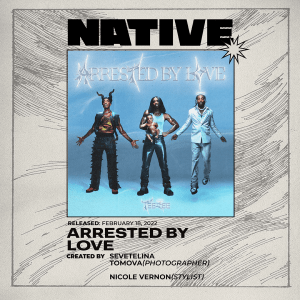
For his first solo project in nearly a decade, ‘Arrested by Love’, Nigerian rap-fusion artist Teezee exudes uncontrollable joy, evidently borne from an assurance in himself as a pioneer, community leader, talented creative and, perhaps most importantly, father. For a project partly inspired by early to mid-2000s Nollywood classics, the cover is fitting for a Nollywood plot from that period—a transformation from devil to saint. Each version of Teezee on the cover is striking in character makeup, a wonderful feat of execution, with the middle portrait of the artist carrying his son adding affection bonus points. Add in the near-bizarro typography of its title and the cover for ‘Arrested by Love’ is a cinematic precursor to the album’s vaunted show of confidence.
Dennis Ade Peter

A strange being menacingly reaching its duplicated arms out takes up the cover of ‘N’Djila Wa Mudujimu’. It’s an unsettling image evoking an afro-futuristic Creature From the Black Lagoon. The darkness that swallows it up from the sides also serves this an eye-catchingly unnerving cover. Led by original founder Pisko Crane, and lead singer Lady Aicha, this iteration of the Congolese band Fulu Miziki, whose moniker roughly translates to “music from the garbage” because they repurpose trash to ‘make their instruments, put together a set of futuristic grooves on N’Djila Wa Mudujimu’, taking the folksy and Congolese pop sounds they grew up on and mutating them into giddy electro-punk bangers.
Underlined by its sci-fi tone, nodding at something set in the distant future or even otherworldly, the image on the cover excellently captures the band’s preference for using things from the past to make forward-facing art. With a gorgeously textured costume made out of repurposed material, the cover represents the slightly off beat tone of the album.
Moore Wright
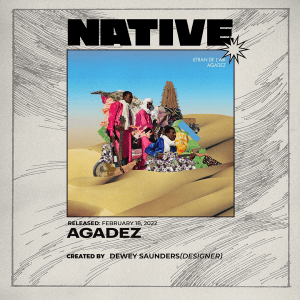
While matching the festive, colourful palette of the album it visualises, there’s also a dedication to realism that makes the cover for Etran de L’Air’s ‘Agadez’ stand out. Occupying a vast breadth of the landscape is the desert sand, which speaks to the acclaimed position of this band in the Saharan rock tradition. Honing their skills by playing at weddings and other events in Agadez, the album pays electric homage to the influence of the small, historical town located in Niger Republic.
There’s a packed atmosphere reflected by the Dewey Saunders cover which centralises three Etran de L’Air members. On view is the dome of a 14th century mosque, rows of animated fabrics and eco life, a motorcycle which embodies the album’s transient quality. Even the colourful kaftans worn by the members foreshadow the tactful breeziness of the songs. Considering their tough early days which sparked creative improvisation, there are few covers out this year which captures the musicians’ trajectory with such coolness, intensity and deliberation.
Emmanuel Esomnofu
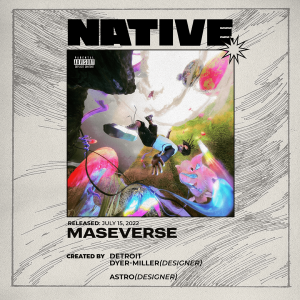
Maison2500 opened the year with the January release of ‘BUFFCORE,’ an 11-track mixtape to prepare listeners for their anticipated sophomore album, ‘Maseverse!’, which eventually arrived in July. A sprawling 22-track project, ‘Maseverse!’ is as indulgent as Maison2500 has ever been, amping up the menacing and trippy appeal of their unique blend of psychedelic trap soundscapes and serrated delivery cadence. On its eye-holding cover, Maison is somewhere between floating and falling within a picturesque scenery, where there’s lush greenery, bright colours and otherworldly creatures. Just like the music, it’s confounding in the way it lures you in and throws you around for a spin.
Wonu Osikoya
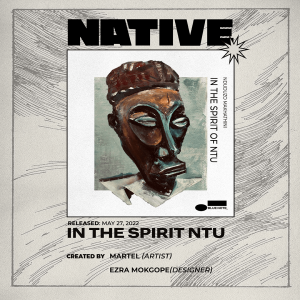
The first release on the Africa imprint of the iconic Jazz label, Blue Note, had to be incredibly special—and it is. Nduduzo Makhatini’s ‘In the Spirit of Ntu’ is a titanic feat of spiritual jazz, an exploration of Ubuntu as the connecting life force between everything with an animate essence. It’s a complex concept that Makhatini and his band of young South African jazz luminaries dig into and present with considered grace and immersive intensity, an excellence that shows in the image of the sculpture that graces its cover. Exuding rustic wisdom, the face on ‘In the Spirit of Ntu’ is magnetic, a stimulating work of art that looks like it’s handing down answers and codes without uttering a single word.
Dennis Ade Peter
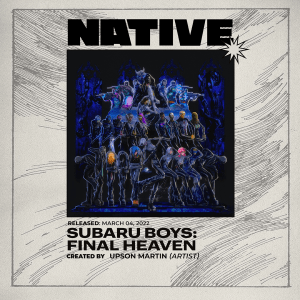
A pristine combination of Cruel Santino’s passion for gaming and anime, the cover for ‘Subaru Boys: FINAL HEAVEN,’ illustrated by Upson Martin, is a perfect representation of creative sensibilities that can easily be tied to Santi’s constant auteur-level artistry. The album itself is a blend of dreamy vocal and music melodies, livewire guest raps, propulsive and occasionally off-kilter beats, with near-clear lyrics—by Santi standards—about rebounding from heartbreak and conquering demons. To the latter thematic point, the mission Santi sets out on with ‘Subaru Boys’ is sublimely reflected in its striking, visually stirring and absorbing cover art.
“The best way to explain this thing is something like, you know how, when you’re going to war, you have your squad with you and everyone is ride or die, you guys kill for each other, and you all love each other to death,” Upson shared with The NATIVE earlier this year. Packed with characters all exhibiting their own poses, it’s a nod to the communal energy that fuels the album. In a design style reminiscent of the popular anime video game, ‘Final Fantasy’, the cover for ‘Subaru Boys’ reiterates Cruel Santino’s commitment to full-length expression, strengthened by his commitment to opening up his seemingly inscrutable music universe with phenomenally executed visual art.
Nwanneamaka Igwe
Written by Emmanuel Esomnofu, Nwanneamaka Igwe, Wonu Osikoya, Israel Ajayi, Moore Wright, Uzoma Ihejirika & Dennis Ade Peter.

